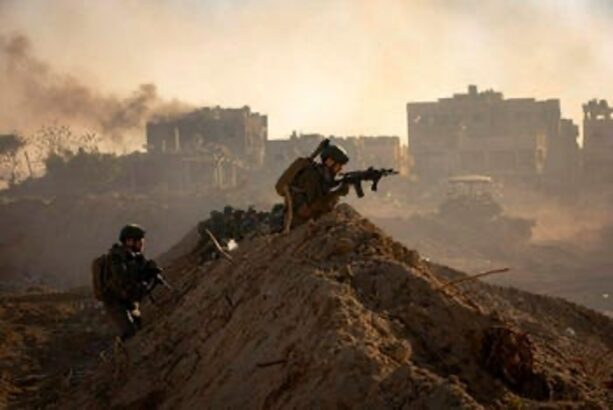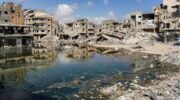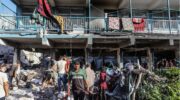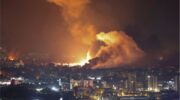The Israeli army says 9,000 terrorists* have been killed since the Gaza war began. Defense officials and soldiers, however, tell Haaretz that these are often civilians whose only crime was to cross an invisible line drawn by the IDF
by Yaniv Kubovich, excerpt reposted from Ha’aretz, March 31, 2024
It was another routine announcement by the Israeli army. Following a rocket launch at Ashkelon, “a terrorist who had fired the rocket was identified and an air force aircraft attacked and eliminated him.” Ostensibly, this was another statistic in the roster of dead Hamas militants.
However, over a week ago, other documentation of the incident surfaced on Al-Jazeera. It showed four men, not one, walking together on a wide path, in civilian clothing. There is no one nearby, only the ruins of houses where people once lived. This apocalyptic silence in the Khan Yunis area was shattered by a loud explosion. Two of the men were killed instantly. Two others were wounded and tried to continue walking. Perhaps they thought they had been saved, but seconds later, a bomb was dropped on one of them. You can then see the other one falling to his knees and then, a boom, fire and smoke.
“This was a very grave incident,” a senior Israel Defense Forces officer told Haaretz. “They were unarmed, they didn’t endanger our forces in the area in which they were walking.” In addition, says an intelligence officer who is familiar with the story, it was not at all certain that they were involved in launching the rocket. He says that they were simply the people who were closest to the launching site – it’s possible they were terrorists, it’s possible they were civilians out looking for food.
This story is but one example, made public, of the manner in which Palestinians are killed by IDF gunfire in the Gaza Strip. The number of dead Gazans is now estimated to be over 32,000. According to the army, some 9,000 of these are terrorists.
However, a host of reserve and standing army commanders who have talked to Haaretz cast doubt on the claim that all of these were terrorists. They imply that the definition of terrorist is open to a wide range of interpretation. It’s quite possible that Palestinians who never held a gun in their lives were elevated to the rank of “terrorist” posthumously, at least by the IDF.
“In practice, a terrorist is anyone the IDF has killed in the areas in which its forces operate,” says a reserve officer who has served in Gaza.
The army’s figures are no secret. On the contrary, over time they have become a source of pride, perhaps the closest thing to a “victory image” Israel has achieved since the war began. But this image, says a senior officer in Southern Command who is very familiar with the issue, is not quite authentic.
“It’s astonishing to hear the reports after every operation, regarding how many terrorists were killed,” he says, explaining: “You don’t need to be a genius to realize that you don’t have hundreds or dozens of armed men running through the streets of Khan Yunis or Jabaliya, fighting the IDF.”
So, what do the battles in Gaza really look like? According to a reserve officer who was there, “usually there is a terrorist, maybe two or three, hiding inside a building. The ones discovering them are combatants with special equipment or drones.”
One of the roles of this officer was to inform senior echelons of the number of terrorists killed in the area he and his men were fighting in. “This wasn’t an official debriefing where they want you to produce all the bodies,” he explains. “They ask you how many and I give a number based on what we see and understand on the ground, and we move on.”
He emphasizes that “it’s not that we invent bodies, but no one can determine with certainty who is a terrorist and who was hit after entering the combat zone of an IDF force.” Indeed, a number of reservists and other soldiers who were in Gaza in recent months point to the ease with which a Palestinian is included in a specific category after his death. It seems that the question is not what he did but where he was killed.

In the heart of a kill zone
The combat zone is a key term. This is an area in which a force sets itself up, usually in an abandoned house, with the area surrounding it becoming a closed military area, but with no clear marking as such. Another term for such areas is “kill zones.”
“In every combat zone, commanders define such kill zones,” says the reserve officer. “This means clear red lines that no one who is not from the IDF may cross, so that our forces in the area are not hit.” The boundaries of these kill zones are not determined in advance, nor is their distance from the house in which the forces are situated.
The height of buildings is also an important factor. Each force has observations posts, within and outside the Gaza Strip, whose soldiers are charged with identifying danger. But ultimately, the boundaries of these zones and the exact procedures of operation are subject to interpretation by commanders in that specific area. “As soon as people enter it, mainly adult males, orders are to shoot and kill, even if that person is unarmed,” says the reserve officer.
To a large extent, the tragedy in which three hostages were killed by the IDF is such a story, since in fleeing from their captors the three entered a kill zone in the middle of the Shujaiyeh neighborhood of Gaza City.
“Battalion 17 was protecting a southern logistical evacuation route used by the division,” said brigade commander Col. Israel Friedler, who was in charge of the force, during an investigation of the incident. “The range of vision and the kill zone were close to our forces,” he said. The end is known, as is the fact that procedures were not followed. Subsequently, procedures were tightened.
Nowadays, if the presence of hostages in an area is known, operations will be carried out accordingly, and such areas will be not be hit from the air. However, what happens in other areas is apparently less regulated. It is unclear how many unarmed Palestinian civilians were shot dead when they entered such zones.
“The feeling we had was that there weren’t really rules of engagement there,” a reservist who until recently was in northern Gaza tells Haaretz. “I don’t remember anyone going over the details with us after every incident.” This corresponds with the impression of a senior defense establishment official. “It appears,” he says, “that many combat forces are writing their own rules of engagement.”
A senior defense official told Haaretz that this issue reached the desk of Chief of Staff Herzl Halevi already at the beginning of the war. When the General Staff realized that the rules of engagement in Gaza are subject to interpretation by local commanders, “the chief of staff came out in the clearest manner against the killing of anyone entering a combat zone. He talked about this in his speeches,” says this official. “Regrettably, there are still commanders, even senior ones, who do as they please in their conduct in the Gaza Strip.”
The orders are still to shoot anyone approaching forces in a combat zone. Since “approaching” is a very subjective term, it is not surprising that it is subject to interpretation on the ground.
A reserve officer with an important role in a forward command post of a reserve brigade at the forefront of the fighting in northern Gaza says that age and experience play a role. In other words, younger conscript soldiers are likelier to pull the trigger, compared to reservists.
This officer was involved in an incident in which innocent people could easily have been killed. “We identified a suspicious man who was about to enter our combat zone,” he relates. “We already had a drone in the air with approval to kill the suspect. Suddenly, at the last moment, we and the drone operator saw the man entering a street and a square, with dozens of people there.” This was a few yards outside the combat zone boundary, where there was a market with stalls, children on bicycles, a parallel world. “We didn’t even know there were civilians there,” he says. They immediately decided to call off the strike, apparently preventing a disaster.
“I have no doubt that there are other forces which would have used the drone,” adds the officer. “There is always tension between protecting our forces, which is the highest priority, and a situation in which you try to avoid unnecessary killing of civilians.”
In all that chaos, a lot of weight is given to the judgment of commanders on the ground, be it a brigade, battalion or company commander, say many combatants who spoke to Haaretz. They say that there are commanders who will shoot at a building with a suspect in it even if there are civilians in the vicinity, while other commanders will act differently.
Throughout our discussions with various defense officials, officers and combatants, the dilemma of distinguishing between a civilian and terrorist kept cropping up. How can you identify someone if you’re in danger, or decide whether it’s right to wait a while without rushing to shoot. Turning to commanders can yield different answers, depending on the person and the situation.
“For our commanders, if we identified someone in our area of operation who was not part of our forces, we were told to shoot to kill,” said a soldier from a reserve brigade in describing his experience. “We were explicitly told that even if a suspect runs into a building with people in it, we should fire at the building and kill the terrorist, even if other people are hurt.”

The test of time
Civilians in Gaza are aware of locations that are defined, at least on paper, as firing zones. They are supposed to remain in and around humanitarian shelters. These are areas in which the IDF does not create combat zones.
But the test of time is relevant here, half a year into the war. “If we were there for a month or two, you could stick with the order that anyone approaching should be shot,” says the officer from the front command post. “But we’ve been there for six months, and people have to start coming out; they are trying to survive, and that leads to very serious incidents.”
These incidents are very troubling for the American administration, which in recent weeks has been demanding that Israel manage its policy of firing as it relates to civilians in a much more responsible manner. And yet, an intelligence officer who is in the thick of combat says that “what is happening in the northern Gaza Strip should not worry the Americans; it should worry Israel.”
He says that “there are over 300,000 civilians there, most of them concentrated in areas the IDF has defined as humanitarian shelters since the beginning of the war.” These people, he says, “are the most disadvantaged people in Gaza, people who didn’t have the money needed to move to the south or to rent an apartment or room, or even to obtain a tent.”
The situation in these areas, he adds, is very difficult. People residing there fight for food and for a place to sleep. He says that it’s become a life-or-death struggle in which violence reigns and governance is absent.
A senior IDF commander who is involved in the combat adds that “in many parts of northern Gaza there are civilians who are not in these humanitarian shelters,” he says. “Some of them simply returned to or stayed in their houses to protect their property from pillage, concerned that someone else would take over their house while they fled.”
Thus, people in their homes, which happen to lie outside the humanitarian shelters where the IDF does not operate, are in clear danger. “They could be in buildings right next to where soldiers are located,” says this commander. “If someone sees them, they are usually hit.” Sometimes they don’t know that they are perceived as posing a danger. Thus, there is an IDF order for Gazans to avoid going on rooftops. Anyone on a roof is liable to be shot.
The senior commander estimates that there were incidents in which civilians tried to reach areas they thought the army had left, possibly in the hope of finding food left behind. “When they went to such places, they were shot, perceived as people who could harm our forces,” says this commander.
One officer mentioned another factor that increases friction with civilians: the fact that in recent weeks the IDF has remained static in many parts of the Strip, without moving to fight in new areas.
“Instead of starting to rebuild and disperse the people in these shelters, soldiers are brought back to the same areas, which have only become more crowded, with people who have much less to lose,” says a reserve officer who has just left a combat zone in Shujaiyeh. This officer believes that the IDF and the entire defense establishment clearly understand that at the end of the fighting, Israel will have to contend with these incidents and their implications vis-à-vis the international community.
Meanwhile, a General Staff investigative team is on the ground, sending its conclusions to the military advocate general. But with no one knowing how many terrorists have been killed and how many civilians have been counted as terrorists, it seems that this team’s task is not a simple one.
In response to questions by Haaretz, the IDF spokesperson said that regard to categorizing the fatalities from IDF fire in Gaza and the number of terrorists killed, “the IDF is in the midst of a war against the Hamas terror organization and is acting to foil threats against its forces. The IDF constantly calls on civilians to evacuate intense combat zones and is investing efforts into allowing civilians to evacuate as safely as possible.”
“In contrast to claims being made, the IDF has not defined ‘kill zones.’ Support for this comes from the fact that the IDF has arrested a large number of terrorists or suspected terrorists during the fighting, without inflicting damage in intense combat zones,” continued the army.
Indeed, there is no written order regarding a kill zone in the IDF’s rule book. But this doesn’t mean that the concept is unknown to soldiers. Evidence of this is the investigation of the incident in which the three hostages were killed.
As for the documented footage of the attack on the four unarmed Gazans, the IDF spokesperson responded that “the area documented in the footage is an active combat area in Khan Yunis, in which there was a significant evacuation of the civilian population. The forces there experienced many encounters with terrorists who fight and move in combat areas, while dressed as civilians, and camouflage combat gear in buildings and property that appear to be civilian.”
“The incident documented in the footage was examined by the investigative apparatus of the General Staff, which is a body that is independent and responsible for examining exceptional incidents that happen in the course of combat,” the army added.
Yaniv Kubovich is military affairs correspondent for Israeli newspaper Haaretz
EDITOR’S NOTE ON THE USE OF THE WORD “TERRORIST”: In reality, international law supports the efforts of resistance groups against an occupying power, even to the point of armed resistance. Hamas has clearly and openly stated that its enemy is not the Jewish people, but the racist ideology of Zionism – the ideology under which Israel dispossessed 750,000 Palestinian people and exiled them to Gaza and other locations.
The use of the word “terrorist” for a group that resists occupation and oppression is a political, not fact-based choice.
RELATED:
- It isn’t Netanyahu who is acting against the will of his people, it’s Biden
- Israel has lost control of the narrative – October 7 truths coming out
- Gaza Becomes Israel’s Testing Ground for US- and Israeli-made Military Robots
VIDEOS:





